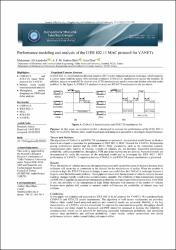Performance modeling and analysis of the IEEE 802.11 MAC protocol for VANETs
Özet
The IEEE 802.11 standard defines the specifications of the media access control (MAC) and physical (PHY) layers for vehicular ad hoc networks (VANETs). In IEEE 802.11, distributed coordination function (DCF) is the fundamental access technique, which employs a carrier sense multiple access with collision avoidance (CSMA/CA) mechanism to access the medium. In addition, request to send (RTS)/clear to send (CTS) mechanism is used to overcome hidden vehicular nodes problem. In this paper, an analytical model is developed to evaluate the performance of the IEEE 802.11 MAC for VANETs. The algorithm of CSMA/CA and RTS/CTS mechanism are presented. Markov chain model based analytical analysis is presented to investigate the performance. Parameters that can influence the performance such as vehicles velocity, vehicle density, contention window size, maximum retransmission limit etc. are considered. The relationship between the performance metrics and parameters are derived. Throughput, packet dropping rate (PDR) and delay expressions are obtained. Moreover, numerical results are demonstrated to verify the analysis. The comparison between CSMA/CA and RTS/CTS access mechanisms is presented.
Cilt
35Sayı
3Bağlantı
https://hdl.handle.net/11363/2189Koleksiyonlar
Aşağıdaki lisans dosyası bu öğe ile ilişkilidir:


















